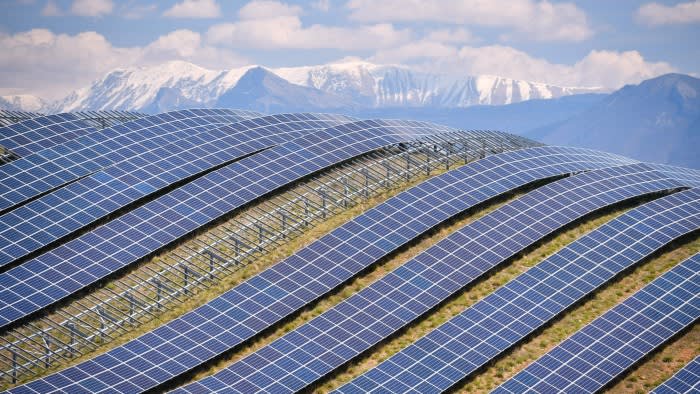Stay informed with free updates
Simply sign up to the Renewable energy myFT Digest — delivered directly to your inbox.
The writer is author of ‘Exponential’
In a single generation, the cost of solar panels has plummeted by an astounding 99 per cent. The price collapse is remarkable. It also proves that energy markets are being propelled by technology.
For centuries, the rhythmic hum of turbines, powered first by coal, then by oil and gas, has been the heartbeat of industrial progress. But their proliferation is less the story of free markets than power and manipulation. As early as the 1870s, John D Rockefeller of Standard Oil colluded and consolidated to manipulate the supply and price of oil. A century later, Opec’s oil embargo plunged the US into recession. We still feel its aftershocks today. Europe’s dependence on Russian natural gas served to reinforce the point: the whims of an autocrat can choke the lifeblood of modern economies.
Now, however, barrels of oil and sacks of coal can be left on the loading yard, replaced by solar panels, wind turbines and batteries.
As markets expand, prices are coming down. This is not just the case for solar photovoltaic panels. Between 1990 and 2023, the price of wind turbines dropped 61 per cent and batteries 97 per cent. In Germany, solar panels are now cheaper than wooden fences. Homeowners can protect their privacy while powering their kitchen appliances.
By contrast, benchmark costs for crude oil, coal and natural gas have increased in real terms over the past century. Consumers have been subjected to the churning volatility of petrochemical politics too. And lowering prices by improving the machines that turn those resources into energy — power plants and engines — is difficult and expensive.
New energy production will therefore follow the path of other technology sectors, with innovation spurring new businesses. Virtual power plants can already string together solar panels from small and large companies, household batteries and sometimes even a slice of an electric vehicle’s battery. The US Department of Energy reckons as much as 8 per cent of peak electricity demand is already met by such collaborative endeavours.
For energy stalwarts, a radically different mindset is required to deal with what is fast becoming a very different world. As the techno-energy system increases efficiency, electricity will become the common currency. Analysts will care less about dollars per barrel of oil and more about cents per kilowatt-hour generated.
Traditional energy power brokers — those endowed with reserves of fossil fuels — will see their global leverage wane. Imbalances will be redistributed. Renewable resources are more equitably and generously distributed. According to Rocky Mountain Institute, every country in the world barring Japan and a handful of nations in eastern and central Europe, have renewable resources capable of meeting their current energy demands 10 times over. The global south is the richest region of them all.
Today’s energy markets do not yet reflect the structure of a technology-driven sector. For one thing, the cost of producing and distributing energy varies by geography. Prices should too. Regional pricing, such as that already found in Texas, is essential to eliminate distortions and encourage investment that drives prices down and capacity up.
Energy technologies have far lower lifetime costs than their fossil counterparts too. After all, once you have bought a solar panel or battery, it does its job without needing to be refuelled with expensive oil and gas. However, upfront prices can be higher than equivalent non-renewable systems, even in the face of staggering declines in cost. Adapting to this system, which is more costly to buy and much cheaper to run, can be aided by the finance industry.
Policymakers also need to make it easier for households and businesses to participate in a properly distributed electricity system. US regulators, who often hail from the fossil fuel industry, have not made it easy for smaller players to compete with incumbents. Adjusting electricity prices based on real-time supply and demand could also help to match energy use with renewable energy production.
Industry must fashion its own response. This means investments in new processes for making steel, cement, glass and the materials upon which the modern world is built.
Scientists from the University of Exeter recently concluded that we have passed a “global irreversible . . . tipping point . . . where solar energy gradually comes to dominate global electricity markets”. Our current political economy has been built around natural resources. This transition will have a profound impact on that structure.
https://www.ft.com/content/969d1a10-0e81-450b-971c-06acd79e4561


